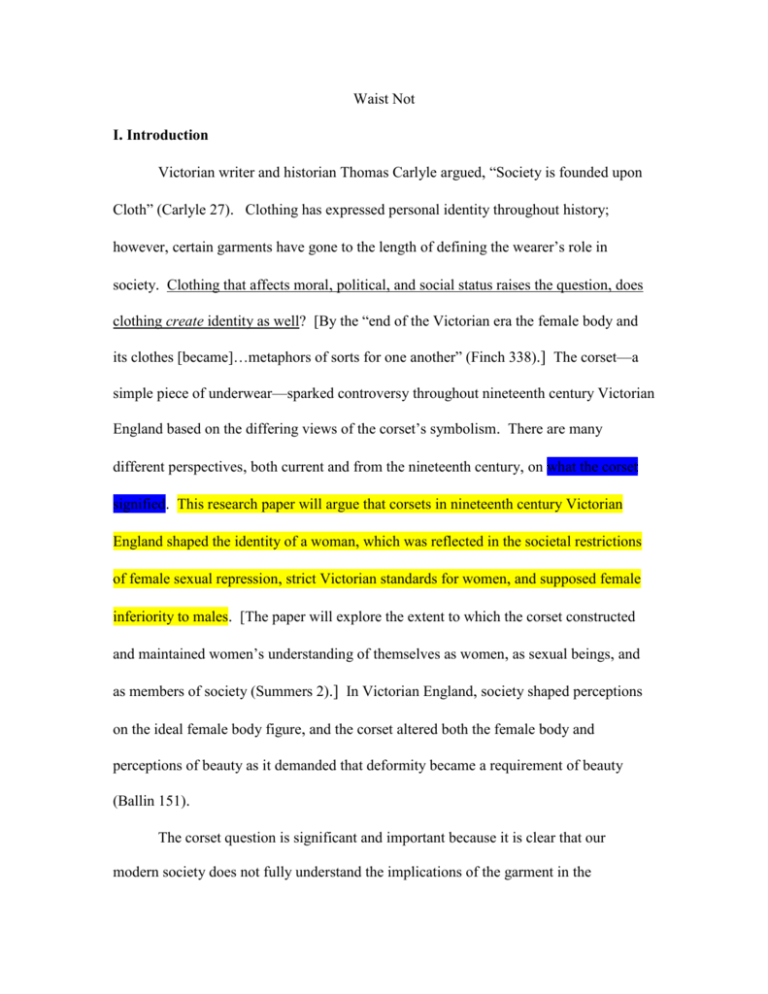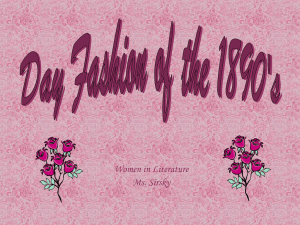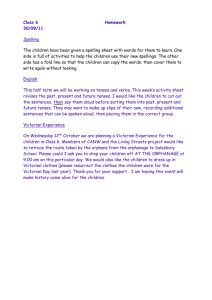
Waist Not
I. Introduction
Victorian writer and historian Thomas Carlyle argued, “Society is founded upon
Cloth” (Carlyle 27). Clothing has expressed personal identity throughout history;
however, certain garments have gone to the length of defining the wearer’s role in
society. Clothing that affects moral, political, and social status raises the question, does
clothing create identity as well? [By the “end of the Victorian era the female body and
its clothes [became]…metaphors of sorts for one another” (Finch 338).] The corset—a
simple piece of underwear—sparked controversy throughout nineteenth century Victorian
England based on the differing views of the corset’s symbolism. There are many
different perspectives, both current and from the nineteenth century, on what the corset
signified. This research paper will argue that corsets in nineteenth century Victorian
England shaped the identity of a woman, which was reflected in the societal restrictions
of female sexual repression, strict Victorian standards for women, and supposed female
inferiority to males. [The paper will explore the extent to which the corset constructed
and maintained women’s understanding of themselves as women, as sexual beings, and
as members of society (Summers 2).] In Victorian England, society shaped perceptions
on the ideal female body figure, and the corset altered both the female body and
perceptions of beauty as it demanded that deformity became a requirement of beauty
(Ballin 151).
The corset question is significant and important because it is clear that our
modern society does not fully understand the implications of the garment in the
nineteenth century. The advertisements and pornography of today understate the
underlying importance of the underwear’s symbolism (Summers 2). By redefining the
public view of corsets that dramatizes the garment in simple sexual terms, society can
gain a deeper understanding of the corset’s role in shaping the identity of Victorian
women, the perceptions of femininity, and the definition of womanhood. Furthermore,
the influence of the corset has carried on throughout history. Nineteenth century trends
reflect attitudes towards fashion in modern day. Corsets shifted the female silhouette
and, one could argue, began the drive to be thin. Dress reformer Gould-Woolson argued
that one major reason for the creation of the garment is its accentuation of the slender
form, which is still admired as a popular trend in modern day society. The corset
contributed to beauty, symmetrical shape, and thin figure (Gould-Woolson 208). In her
book on the history of feminism, Susan Brownmiller comments that there can be no real
discussion of the feminine body in the western world without understanding the
implications of the corset, because the garment has played a “starring role in the [female]
body’s history” (Brownmiller 19). By examining the corset question, one may discover a
new meaning to the phrase, “you are what you wear,” and reconsider what clothing says
about an individual, and about a culture, as a whole.
The influence of the corset is also significant considering the harmful bodily
effects of tight lacing. There are medical consequences of forcing the female body to
assume the shape of an hourglass through unnatural means. Tight lacing shifts internal
organs and ribs downwards and away from the waist (Kortsch 65). Richardson provides
a realistic depiction of a “post-corset” body as cut with “fierce red lines…[and] criss-
crossed with red furrows, from the variety of strings and bones that had lashed”
(Richardson 470-73) and scarred the skin. In a society that “considered female ill health
as normative to femininity” (Summers 125), Victorian women went to startling and
frightening lengths to comply with society’s standards of beauty.
II. Literature Review
Throughout the research literature, various themes have stood out as prominent.
Christine Bayles Kortsch comments in her book that corsets could signify practically
anything, which makes controversies regarding the garment particularly meaningful
(Kortsch 56). She presents an array of perspectives on corsets, and addresses the major
themes present in most of the research literature. The themes include Victorian fashion
expectations and standards, female sexuality, and gender roles.
IIa. Victorian Standards of Morality
The corset was a fashion expectation that reflected strict Victorian ethical
standards; the garment restrained a woman to these standards and therefore rendered her
a slave to both fashion and society. In this sense, the corset figuratively bound a woman
as well as literally. In the 1800’s, corsets became “mandatory underwear” (Kortsch 62)
and not wearing a corset led to a great amount of social scrutiny (59). Society defined
the corset as a garment that embodied social status, class, and etiquette. The social
expectations of women to wear a corset were great; challenging the standards could lead
to ridicule, loss of femininity, and even destruction of respectability.
In a time where dress determined morality as much as actions did, corsets could
make or break a woman’s social image. The influential nineteenth century writer and
editor Sarah Hale argues that dress is a necessity for more reasons than climate, comfort,
and social elegance. Clothing acts as an index of conscience and expresses better than
words “the inner life of heart and soul…and also the tendencies of individual character”
(Hale 39). Fashion was incredibly important in that era, because a working or middle
class woman’s appearance could greatly affect her reputation (Summers 21). Finch
agrees with Kortsch’s argument and states that corsets signified fashionableness in many
class statuses—middle, upper-middle, and upper class women—and became something
of a “hallmark of virtue” (Finch 343). Because of the strict fashion expectations, corsets
turned women into “slaves to fashion” (Kortsch 56)—females willing to conform their
style and deform their bodies to follow social standards. The title alone of Helene
Roberts’ scholarly article, “The Exquisite Slave: The Role of Clothes in the Making of
the Victorian Woman,” suggests that corsets created the identity of a woman and formed
her into a willing slave of oppressive society. For instance, Victorian sleeves sheathed
the arms tightly and corsets bound the waist to the point of constraining and inhibiting
movement. Crinoline, which replaced the petticoat, literally caged the woman in with
hoops of steel (Roberts 557). The literal restriction of the corset is metaphoric of the
figurative social restrictions upon women.
IIb. Victorian Definition of Beauty and Female Sexuality
Western society’s fashions have changed and been variously designed throughout
history to help the female body look beautiful according to the culture’s terms. In the
nineteenth century, the corset represented beauty according to Victorian definition. The
ideal figure of that time was small, youthfully girlish, and delicate, and a small waist was
a crucial element of achieving this look (Kortsch 62). The corset also accentuated what
the Victorian era considered to be the female erotic zones. The shifting of erogenous
regions was one reason behind the creation and shape of the garment, which emphasized
the waist as the primary erogenous zone of the female upper body (Kortsch 61). Women
deformed their bodies not only to conform to society’s perception of beauty, but also to
satisfy sexual desires on behalf of men; therefore, the corset acted as a means of female
sexual repression. Finch explores a slightly different perspective on corsets, examining
the differences between “pre-modern” and “modern” female bodies. However, the
authors both come to the conclusion that whereas the earlier role of the woman was for
procreation, the corset “reconfigured [the woman] as an erotic field” (Finch 346) and
therefore objectified a woman for male sexual imagination.
Other research literature expands on Kortsch’s points and argues specific
perspectives on the extent to which the corset reinforced patriarchal constructions of
sexuality. The corset became the outward reflection of nineteenth century sexual
attractiveness, because it highlighted the narrow waist and also heightened the appeal of
secondary sexual characteristics—the breasts, buttocks and hips (Kotsch 60). Kortsch
addresses the many contradictory nineteenth century cultural judgments caused by
corsets. The way a woman chose to wear or not to wear a corset influenced interpretation
and projection of female sexuality. For instance, Kortsch explains two common
opposing viewpoints. One of these perspectives holds that “tight-lacers” wore corsets to
arouse impure desires on behalf of men, whereas the other believed that not wearing a
corset signified sexual promiscuity and moral negligence. In either case, the corset is a
factor in creating a woman’s identity, because it allowed society to label a woman based
solely on her dress and its sexual and moral implications.
A major debate is whether corsets acted as tools of female sexual repression, or of
female sexual freedom. Roberts argues that men demanded a submissive ideal from
females (Roberts 564), and the body-deforming corset is a perfect example of female
conformity to meet male sexual desire. Modern historian Leigh Summers supports and
furthers the belief of corsets as a means of sexual repression by stating that corsets were a
“part of misogynistic efforts to control female sexuality” (Summers 2001), a view
common among feminists. This perspective holds that corsets worn by Victorian women
clearly sent the message of willingness to conform to society and in particular, to
sexuality that was masochistic and male dominated.
David Kunzle also writes about the significance of female fashion and its
symbolic role in society, yet he argues against the claim that corsets represented female
sexual repression. He quotes the Englishwoman’s Domestic Magazine, “women
[declared] their pleasure in submitting to male taste for small waists” (Kunzle 572). This
perspective suggests that corsets were a symbol of sexual expression and freedom.
Along this same thought, modern day historians have not fully acknowledged that the
corset may have had deeper meaning to women in that time period. The corset is
paradoxical in the sense that it embodied modesty and respectability, yet at the same time
evoked strong sexual appeal. The garment may have provided women with a culturally
accepted outlet for eroticism in an era that repressed female sexuality and denoted it as
insignificant (Summers 6).
After analyzing the research literature on the debate over the symbolism of the
corset, evidence supports that corsets were used mostly as tools of sexual repression.
David Kunzle’s perspective on corsetry representing sexual freedom is thought
provoking; however, there are some holes in his research, which ignores the harmful
medical consequences of tight lacing on the female body. Furthermore, a reviewer
pointed out, “lack of evidence also leads Kunzle to give undue weight to magazine
articles” (Gilbert 1361), leaving the reader unsure whether or not Kunzle’s research
literature signifies major and important tight-lacing battles. Corsets cannot be considered
as a means of expressing female sexual freedom. The harmful medical effects and harsh
physical restrictions of the corset clearly suggest the male attempt to control and maintain
female sexual submissiveness and objectification.
Corsets strengthened men’s attempts to control female sexuality, but women also
played a role in complying with their own objectification. In general, men were in
control of corset patents and the corset industry (Summers 30), but women may have
been aware of the patriarchal sexual constructions. Women were not “cultural dupes” but
rather “agents in the construction of their own (sexual) subjectivity” (Summers 5) and
chose to wear corsets despite discomfort, restriction, and dangers to health. For this
reason, feminists who understood the sexual politics of corsetry refused to support the
fashion specifically because of its role in female subjugation (Summers 5).
Although some women chose to willingly submit to society and male indulgence,
other cases reveal females as subservient. Many women, often girls, were forced to tight
lace, as documented through letters published in various Victorian magazines. The
letters include the statement, “Up to the age of fifteen…I was subjected to the strict and
rigid system of lacing” (Steele 66) and a description a girl’s whipping after her refusal to
be laced smaller than eighteen inches (Steele 68). Whether or not women willingly
submitted to corsetry, the garment reinforced the patriarchal Victorian society that
attempted to control and repress female sexuality.
IIc. Gender Roles
Corsets supported the common conceptions of female inferiority to males in
nineteenth century Victorian England by shaping the body into a form that scientists
deemed inferior, limiting women to their conventional role in the home, and binding
them to the Victorian code of femininity. In that time, scientists were fascinated by the
“nature” of a woman—the anatomy of the female body—and scientists used their
findings on female anatomy to answer social issues such as women’s rights. The
scientific studies were used to “prove” male superiority and to justify social inequalities
between the sexes (Schiebinger 43). The corset, along with scientific studies based on
corseted body figures, endorsed the unfounded conception of female inferiority. For
instance, the d’Arconville skeleton, which was popular in Britain, depicts extremely
narrow ribs, suggesting that d’Arconville had chosen a model that had tight laced
throughout her life (Schiebinger 59). The larger female pelvis in this skeleton was used
“in parallel to fashion to prove that women were naturally destined for motherhood”
(Schiebinger 43), and thereby confined to that role in society.
The controversy is not whether or not nineteenth century females were believed to
be inferior to males, but rather, whether or not corsets were a symbol of inequality, or
liberation. For instance, many nineteenth century pundits believe that the demise of tight
lacing was a victory for women, liberty, and social progress. However, Kunzle points
out that enemies of the corset were “motivated not by libertarian, feminist, or progressive
sympathies,” but rather by an autocratic mindset. Those against the garment were often
tyrannical males with a low opinion of the female gender (Kunzle 570) who opposed
corsetry because it hindered what they believed to be a woman’s primary role as a child
bearer. On the one hand, this perspective believes that those women that championed the
corset stood up against the conception of male authority and superiority. On the other
hand, the corset was instrumental as a restrictive piece of clothing because it rendered a
woman incapable of performing manual labor (Summers 21), and in that sense, the corset
confined women to the societal role of homemaker and supported the notion of male
superiority.
The research literature suggests that the fear behind the un-corseted body was
rooted in the threat of shattering these conventional gender roles. Corsets gave women a
particular demeanor of physical vulnerability, uncertainty, and insecurity (Summer 125).
Not only did this female appearance of weakness and need for protection boost male ego
and reinforce the conception of male superiority, but these traits were also admired and
sensualized in Victorian popular culture (Summers 125). This eroticization and
feminization of the corset suggests that the abandonment of corsetry would pose a major
threat to conventional gender roles, especially considering that people believed
“uncorseted female flesh” was “inadequately gendered” (Summers 144). The thought of
fashion without corsetry shook the male ego and caused anxiety in two main ways. First,
female opposition to corsetry and social restrictions would give women the strength,
power, and desire to demand equality. Second, the female body ran the risk of
masculinization, because without the garment, the female body became unsexed and
would allow for physical fitness. For autocratic males, this was as upsetting and risky as
female movements for suffrage (Summers 148). The body, sans corset, “epitomized the
spirit of emancipation that inspired women to break free of some of the more restrictive
elements of the Victorian code of femininity” (McCrone 224-8). By abandoning the
corset, women were able to break free of societal restrictions that the corset constructed
and supported.
The research literature shows that there are many perspectives on various social
aspects regarding the controversial topic of corsets in nineteenth century Victorian
England, and explores universal themes such as sexuality, Victorian social and moral
standards, and gender roles. The research literature supports the claim that the corset
acted as a means of female societal restriction. Women conformed not only to society,
but also to a society that was male dominated. Corsets altered the female body according
to the Victorian definition of beauty and objectified women to please male sexual desires.
After analyzing the research literature, it is clear that the corset did more than just express
style; it also played a major role in creating and shaping the identity of women as
females, as sexual beings, and as members of society.
III. Conclusion
Sarah Hale comments that the art of dress unites “both as cause and consequence
of this civilization” (Hale 45). The nineteenth century Victorian England corset is a
prime example of how clothing both shapes and is a product of the wearer’s role in
society. Although many view fashion as a trivial and frivolous topic, Hale argues that
fashion has such a strong connection with thought and intellect that one can render it a
type of progress (42). In the world, wherever there is free thought, fashion transforms
throughout history according to societal and various other changes. Hales muses, “Is
there not the greatest improvement in human race where the fashions of dress are most
likely to change?” (44). The corset, a unique garment, elicited the most response, both in
support and opposition, in fashion history, and sparked a fervor of dress reform for
decades to come. Never has a garment held such significance both in its own time, where
it prompted female campaigns for rights and equality, and in modern day, where we can
still see variations of the corset’s influence. There are many perspectives on the corset’s
symbolism, and through analysis of the research literature, this paper comes to the
conclusion that corsets in nineteenth century Victorian England shaped the identity of a
woman as the garment constructed the definition of femininity and womanhood in terms
of female societal position. The garment also reflected the societal restrictions of female
sexual repression, strict Victorian standards for women, and supposed female inferiority
to males. The corset became far more than a physical article of clothing; it affected the
lives and minds of women in Victorian England and came to symbolize intangible
concepts. The corset was a major factor in the construction of a submissive female
identity and role in society, yet those who understood the politics of corsetry made great
strides in fighting for women’s rights. This paper reexamines the contemporary,
simplistically sexualized view of corsets in order to discover a deeper understanding of
the corset’s role in shaping the identity of Victorian women, and how women both
complied to, and overcame, their societal restrictions.
Works Cited
Ballin, Ada S. The Science of Dress in Theory and Practice. London: Sampson Low,
Marston, Searle & Riving- ton, 1885.
Brownmiller, Susan. Femininity. London: Simon & Schuster, 1986. Print.
Carlyle, Thomas. Collected Works of Thomas Carlyle. New York, NY: Greystone Press,
27. Print.
Finch, Casey. "‘Hooked and Buttoned Together’: Victorian Underwear and
Representations of the Female Body.” Victorian Studies 34.3 (1991): 337.
Academic Search Complete. EBSCO. Web.
Gilbert, Arthur N. "Fashion and Fetishism (Book Review)." American Historical Review
87.5 (1982): 1361. Academic Search Complete. EBSCO. Web.
Gould-Woolson, Abba. Dress Reform: A Series of Lectures Delivered in Boston, On
Dress As It Affects The Health of Women. Boston: Robert Brothers, 1874.
Hale, Sarah. Manners; Or, Happy Homes and Good Society All the Year Round. Boston:
J.E. Tilton and Company, 1868. Print.
Kortsch, Christine. Dress Culture in Late Victorian Women’s Fiction: Literacy, Textiles,
and Activism. Burlington, VT: Ashgate Publishing Company, 2009. Print.
Kunzle, David. “Dress Reform as Antifeminism: A Response to Helene E. Roberts’
‘The Exquisite Slave: The Role of Clothes in the Making of the Victorian
Woman’,” Signs 2.3. The University of Chicago Press, 1977. Print.
McCrone, Kathleen. Playing the Game: Sport and the Physical Emancipation of English
Women. Lexington: The University Press of Kentucky, 1988. Print.
Richardson, Henry. “The Bathe: A Grotesque,” in Dale Spender (ed.), The Penguin
Anthology of Australian Women’s Writing. Penguin Books Ltd.,1989.
Print.
Roberts, Helene. “The Exquisite Slave: The Role of Clothes in the Making of the
Victorian Woman,” Signs 2.3. The University of Chicago Press, 1977. Print.
Schiebinger, Londa (1987): Skeletons in the Closet. The First Illustrations of the Female
Skeleton in Eighteenth-Century Anatomy, in: Gallagher, Catherine/Laqueur,
Thomas (eds.): The Making of the Modern Body. Sexuality and Society in the
Nineteenth Century, Berkely/ Los Angeles/London: University of California
Press, S. 42–82.
Steele, Valerie. Fetish: Fashion, Sex and Power. New York: Oxford University Press,
1996. Print.
Summers, Leigh. Bound to Please: A History of the Victorian Corset. New York: Berg,
2001. Print.







